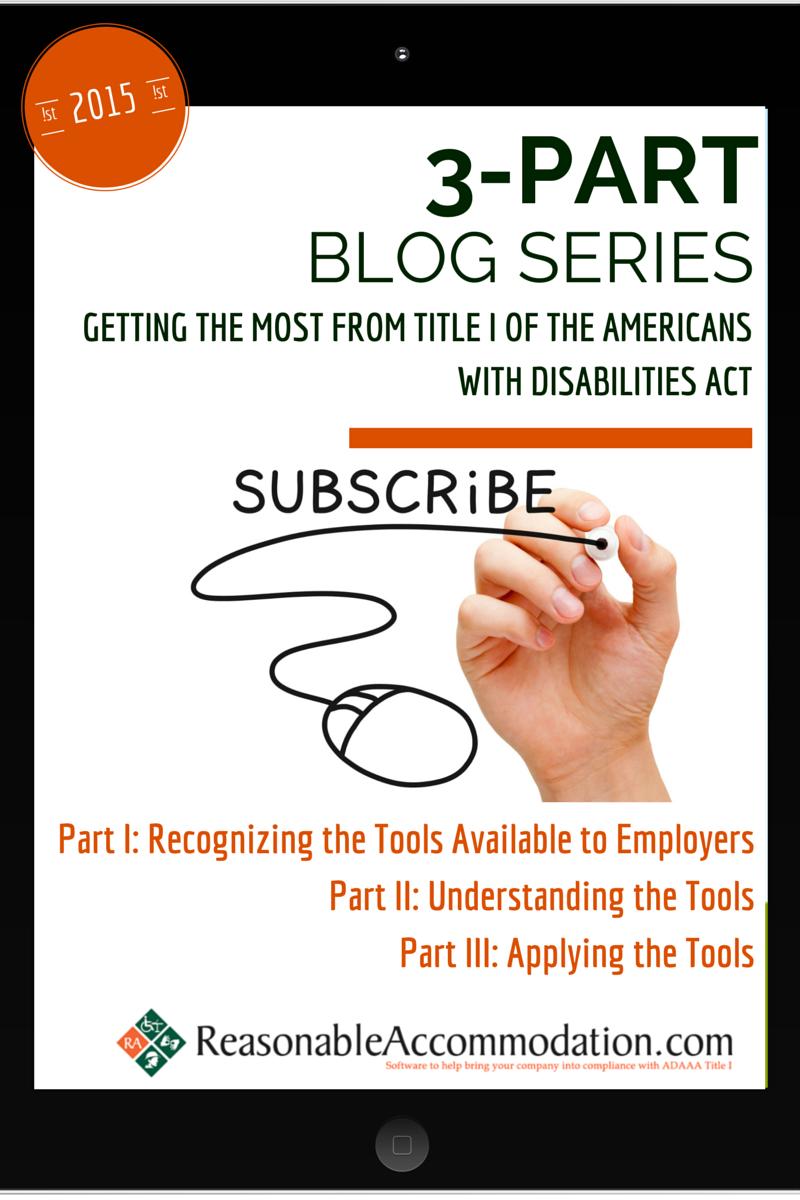Informed Hiring, Return to Work, and Stay-at-Work
This three part blog series will acquaint you with the hiring, disability, and absence
management tools Congress provided to employers through Title I of the amended Americans with Disabilities Act.
Module One – ADA Title I: Recognizing the Tools Available to Employers
This first module will assist you in recognizing each of the tools available in the law. It will include an overview of which sections of Title I pertain to the tools that are important to employers and a brief explanation of each tool will follow.
Module Two – ADA Title I: Understanding the Tools Available to Employers
The Congress of the United States, the Equal Employment Opportunity Commission and the Federal Courts have each shaped how the tools available to employers under Title I of the amended ADA can legally be used. Understanding the use of each tool in reasonable accommodation, hiring, SAW, and RTW scenarios are the subjects of this blog.
Module Three – ADA Title I: Applying the Tools Available to Employers
Human resource, safety, and risk management professionals exercise leadership in company, school, or government agencies through adoption and effective use of the tools provided by Title I of the ADA. Hiring, training, and maintaining an effective workforce is made easier once recognition, understanding, and application of the tools occurs. The final module in this three-part series will review recent EEOC or federal court settlements that affirm use of each of the tools.
************************************************************************************
Module One – ADA Title I: Recognizing the Tools Available to Employers
At first reading, Title I of the ADA seems to focus on prohibitions placed on disability and absence managers. But don’t be fooled – a deeper and wider reading of the federal court’s enforcement of the law reveals not just restrictions but allowed practices acceptable to the court. The italicized sections below come directly from the law; each is followed by a brief explanation of condoned uses of these tools:
SUBCHAPTER I [TITLE I] – EMPLOYMENT
DEFINITIONS
SEC. 12111.
As used in this subchapter:
(3) Direct threat. – The term “direct threat” means a significant risk to the health or safety of others that cannot be eliminated by reasonable accommodation.
When an individual is deemed to be unsafe to self or others, the law provides steps to be taken.
(8) Qualified individual. – The term “qualified individual” means an individual who, with or without reasonable accommodation, can perform the essential functions of the employment position that such individual holds or desires. For the purposes of this subchapter, consideration shall be given to the employer’s judgment as to what functions of a job are essential, and if an employer has prepared a written description before advertising or interviewing applicants for the job, this description shall be considered evidence of the essential functions of the job.
Title I emphasizes that an individual must be qualified for the position to which they are applying or which they hold, in order to be hired, to remain in the position, or to receive certain benefits of the law.
(9) Reasonable accommodation. – The term “reasonable accommodation” may include-
(A) making existing facilities used by employees readily accessible to and usable by individuals with disabilities; and
(B) job restructuring, part-time or modified work schedules, reassignment to a vacant position, acquisition or modification of equipment or devices, appropriate adjustment or modifications of examinations, training materials or policies, the provision of qualified readers or interpreters, and other similar accommodations for individuals with disabilities.
Reasonable accommodation is one of the major tools provided to both employees and employers for managing hiring, stay-at-work, and return-to-work situations. If one strips away everything else involved in Title I, the spirit of equal opportunity in employment and active involvement in reasonable accommodation are the core principles of Congress’ intent.
(10) Undue hardship. –
(A) In general. – The term “undue hardship” means an action requiring significant difficulty or expense, when considered in light of the factors set forth in subparagraph (B).
Undue hardship was intended to recognize that some accommodations are not reasonable. Of all the concepts in the law, undue hardship remains one of the least defined and hardest to interpret.
(d) Medical examinations and inquiries. –
(1) In general. – The prohibition against discrimination as referred to in subsection (a) of this section shall include medical examinations and inquiries.
This section in the law is one of the most powerful tools available to employers. Although national conferences and blogs pay a lot of attention to Reasonable Accommodation, my belief is that medical examinations as a tool, for better or worse, will gather more and more attention as they are recognized as tools to manage stay-at-work and return-to-work cases.
(2) Pre-employment. –
Prohibited examination or inquiry. – Except as provided in paragraph (3), a covered entity shall not conduct a medical examination or make inquiries of a job applicant as to whether such applicant is an individual with a disability or as to the nature or severity of such disability.
(A) Acceptable inquiry. – A covered entity may make pre-employment inquiries into the ability of an applicant to perform job-related functions.
“Post-offer” employment tests are often confused with the law’s “pre-employment” examinations. It is important to know that a pre-employment examination administered by medical personnel is not permitted; a post-offer test comes under the “employment entrance examination” portion of the code.
(3) Employment entrance examination. – A covered entity may require a medical examination after an offer of employment has been made to a job applicant and prior to the commencement of the employment duties of such applicant, and may condition an offer of employment on the results of such examination, if-
An employment entrance examination is intended to identify the individual who is unable to safely execute the physical demands of the essential functions of a job; in error it is often thought that this examination identifies those who can do the job.
(4) Examination and inquiry. –
(A) Prohibited examinations and inquiries. – A covered entity shall not require a medical examination and shall not make inquiries of an employee as to whether such employee is an individual with a disability or as to the nature or severity of the disability, unless such examination or inquiry is shown to be job related and consistent with business necessity.
(B) Acceptable examinations and inquiries. – A covered entity may conduct voluntary medical examinations, including voluntary medical histories, which are part of an employee health program available to employees at that work site. A covered entity may make inquiries into the ability of an employee to perform job-related functions.
(C) Requirement. – Information obtained under subparagraph (B) regarding the medical condition or history of any employee are subject to the requirements of subparagraphs (B) and (C) of paragraph (3).
As mentioned above, the medical examination and inquiry section of the code is one of the most powerful tools given to both employees and employers. As this section of the law is further understood by human resource professionals its use as a tool to manage stay-at-work, return-to-work, and direct threat cases will become commonplace.




